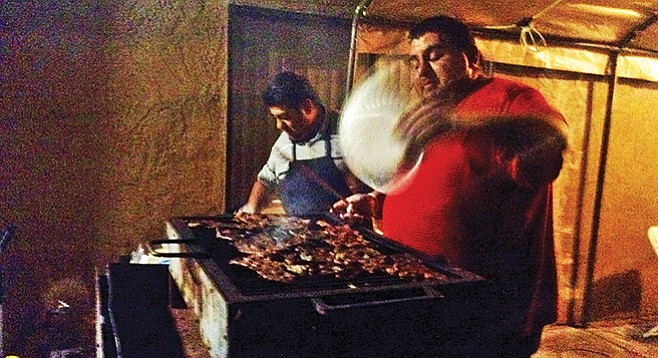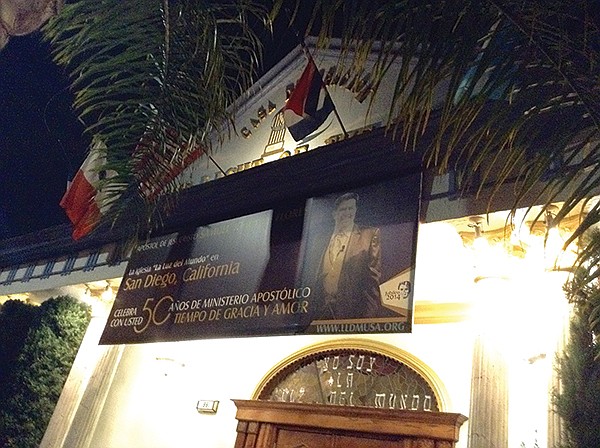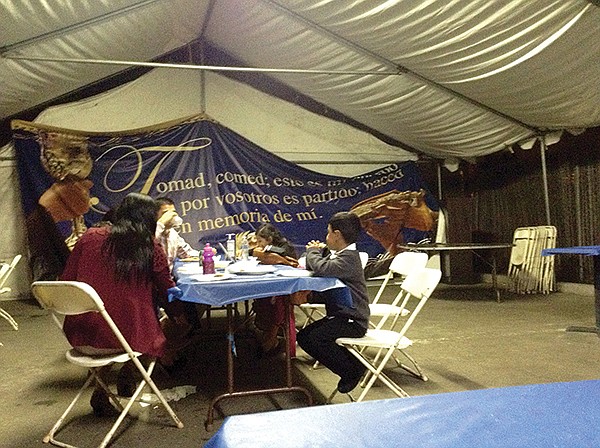 Facebook
Facebook
 X
X
 Instagram
Instagram
 TikTok
TikTok
 Youtube
Youtube

It’s dark in the Barrio. Seven o’clock, Sunday night. I’m hoofing it along Logan Avenue. Muttering to myself. “Late again...”
Because everything is closed. Carla will have eaten. Gotta have something. I hurry past Cuatro Milpas and its extension La Victoria, the ancient eatery of the Barrio. Now they’re dark, closed, just another pair of ancient houses.
But now, nothing. No lights, no lit-up signs saying “Eatery” or “Comida.”
On the other hand, I am starting to hear a buzz of people, laughing, greeting, chatting in Spanish. Kids chase each other in and out of the legs of their parents and grandparents. The crowd swells out onto the sidewalk.
The place they’ve all just come out of is this church, La Luz del Mundo. “The Light of the World.” It looks like a Greek temple. Spanish-language banners say something about “50 years of apostolic ministry.”

“We are an apostolic church,” says this man. “We serve in 50 countries, 6 continents. Are you hungry?”
Actually, as he’s been talking, my nostrils have started twitching. Seems like barbecue smoke drifting by. I walk a little further, and there, in a dirt courtyard beside the church, a bunch of canopies shelter tables and folding chairs. Men cook carne asada over hot coals, women stir frijoles in ollas, and others pour golden streams of melted cheese onto nachos. Strung up lights dance as the tents move in the breeze. Kinda reminds me of the firefighters’ tent city at Gillespie Field during the wildfires in ’07.
Toward the rear, people sit, eat, talk at long tables. At the end of the tent is a big blue and gold banner that reads (in Spanish), “Drink, eat, for this is my body…do this in memory of me.”
“We make food here just about every night,” says another gent named Horem Barrientos, who’s organizing people into lines. “Please. This is the line for the tacos.”
“We make carne asada tacos, nachos, and empanadas after the evening service,” says Hilda Aquina. “Different groups come to cook on different nights. Anybody can come to eat. You don’t have to belong to the church. We do charge a little, like $2 for the carne asada tacos, $1.50 for the nachos, $1.50 for the empanadas. We use the money for our expenses. Or to help our sister churches in Tijuana.”
Long and short is, this will do just fine for me. I join the line. It buzzes with families, and lots of grown sons collect food to take back to their aging parents who’ve sat down under the eating tent.
The line moves slowly because, well, everybody’s talking. Must be about the sermon. I struggle to tune in to as much Spanish as I can pick up. “The Light of the World Church started in 1926, in Mexico, Guadalajara,” a woman explains to me. “Now we’re on six continents. We don’t believe in idols, we don’t celebrate Christmas, women dress conservatively. And our leaders have special powers. Samuel Joaquín Flores guided us for 50 years. Now his son, Naason Joaquín García, says God has spoken to him directly, telling him he should be the next leader. God spoke to him!”
Meanwhile, César, a big cook, is fanning away at the coals with a paper plate to help sear the meat on top. The smoke’s whiplashing everywhere. I tell Horem I’ll take two tacos with all the fixin’s, plus an orange soda. I hand over $5 and watch while this guy Jorge ladles out some steaming frijoles, then splats some pico de gallo over them.
I pass Amelia. She’s spreading hot cheese over a basket of corn chips. She has been baking these chips all day. “Want some?” she says. Ooh. I pay $1.50 for her nachos and — what the heck — from the next lady, I get a custard-stuffed empanada for a dollar.

So, by the time I offload everything, the tacos, the nachos, the empanada, and the drink, I’m down eight bucks. Place is ricocheting with kids playing in the gravel, oldies talking, parents hovering between the two. Nobody seems lonely. That’s the thing you notice. This is what they do after church. Happens every night, seems.
I chomp the tacos first and they are totally delicious. Something about being hungry and them being grilled over coals... Then I start to dip my nachos into the reservoir of cheese.
“Know where the original nachos came from?”
It’s this older guy, eating an empanada across the table. Handlebar mustache. Looks like a vaquero.
“Not really,” I say. “Frito-Lay?”
“No way. They come from Piedras Negras. It’s just across the border from Eagle Pass, Texas,” he says. “Mr. Ignacio Anaya there, he invented them. The nickname for ‘Ignacio’ is ‘Nacho.’ Back in 1943, the wives of some U.S. soldiers were visiting and wanted a snack. Ignacio was a cook, but his diner was closed. So, he cut up some corn tortillas, deep-fried them, melted some cheddar cheese, and sliced some jalapeño peppers. That was it. The wives loved them, took them back to Texas, and the rest is history. There’s a plaque to him down there. And every year, October 21st is the International Day of the Nacho.”
Huh. Never realized Nacho was short for Ignacio. Hope he got rich. I crunch through my nachos, trying to stop the warm liquid cheese from drooling out the bottom.
I look around. The kids, the conversations continue. It’s like we’re on a ship together.
“Welcome,” says Horem, the gatekeeper guy, when I thank him on the way out. “We like anybody to come and eat. So they can meet us and also, yes, because their money helps us with our church projects.”
So, okay, God speaks directly to their leader. But these people have good hearts. Heck, they let in a wretch like me. When it comes to breaking bread together, I appreciate the gesture.


It’s dark in the Barrio. Seven o’clock, Sunday night. I’m hoofing it along Logan Avenue. Muttering to myself. “Late again...”
Because everything is closed. Carla will have eaten. Gotta have something. I hurry past Cuatro Milpas and its extension La Victoria, the ancient eatery of the Barrio. Now they’re dark, closed, just another pair of ancient houses.
But now, nothing. No lights, no lit-up signs saying “Eatery” or “Comida.”
On the other hand, I am starting to hear a buzz of people, laughing, greeting, chatting in Spanish. Kids chase each other in and out of the legs of their parents and grandparents. The crowd swells out onto the sidewalk.
The place they’ve all just come out of is this church, La Luz del Mundo. “The Light of the World.” It looks like a Greek temple. Spanish-language banners say something about “50 years of apostolic ministry.”

“We are an apostolic church,” says this man. “We serve in 50 countries, 6 continents. Are you hungry?”
Actually, as he’s been talking, my nostrils have started twitching. Seems like barbecue smoke drifting by. I walk a little further, and there, in a dirt courtyard beside the church, a bunch of canopies shelter tables and folding chairs. Men cook carne asada over hot coals, women stir frijoles in ollas, and others pour golden streams of melted cheese onto nachos. Strung up lights dance as the tents move in the breeze. Kinda reminds me of the firefighters’ tent city at Gillespie Field during the wildfires in ’07.
Toward the rear, people sit, eat, talk at long tables. At the end of the tent is a big blue and gold banner that reads (in Spanish), “Drink, eat, for this is my body…do this in memory of me.”
“We make food here just about every night,” says another gent named Horem Barrientos, who’s organizing people into lines. “Please. This is the line for the tacos.”
“We make carne asada tacos, nachos, and empanadas after the evening service,” says Hilda Aquina. “Different groups come to cook on different nights. Anybody can come to eat. You don’t have to belong to the church. We do charge a little, like $2 for the carne asada tacos, $1.50 for the nachos, $1.50 for the empanadas. We use the money for our expenses. Or to help our sister churches in Tijuana.”
Long and short is, this will do just fine for me. I join the line. It buzzes with families, and lots of grown sons collect food to take back to their aging parents who’ve sat down under the eating tent.
The line moves slowly because, well, everybody’s talking. Must be about the sermon. I struggle to tune in to as much Spanish as I can pick up. “The Light of the World Church started in 1926, in Mexico, Guadalajara,” a woman explains to me. “Now we’re on six continents. We don’t believe in idols, we don’t celebrate Christmas, women dress conservatively. And our leaders have special powers. Samuel Joaquín Flores guided us for 50 years. Now his son, Naason Joaquín García, says God has spoken to him directly, telling him he should be the next leader. God spoke to him!”
Meanwhile, César, a big cook, is fanning away at the coals with a paper plate to help sear the meat on top. The smoke’s whiplashing everywhere. I tell Horem I’ll take two tacos with all the fixin’s, plus an orange soda. I hand over $5 and watch while this guy Jorge ladles out some steaming frijoles, then splats some pico de gallo over them.
I pass Amelia. She’s spreading hot cheese over a basket of corn chips. She has been baking these chips all day. “Want some?” she says. Ooh. I pay $1.50 for her nachos and — what the heck — from the next lady, I get a custard-stuffed empanada for a dollar.

So, by the time I offload everything, the tacos, the nachos, the empanada, and the drink, I’m down eight bucks. Place is ricocheting with kids playing in the gravel, oldies talking, parents hovering between the two. Nobody seems lonely. That’s the thing you notice. This is what they do after church. Happens every night, seems.
I chomp the tacos first and they are totally delicious. Something about being hungry and them being grilled over coals... Then I start to dip my nachos into the reservoir of cheese.
“Know where the original nachos came from?”
It’s this older guy, eating an empanada across the table. Handlebar mustache. Looks like a vaquero.
“Not really,” I say. “Frito-Lay?”
“No way. They come from Piedras Negras. It’s just across the border from Eagle Pass, Texas,” he says. “Mr. Ignacio Anaya there, he invented them. The nickname for ‘Ignacio’ is ‘Nacho.’ Back in 1943, the wives of some U.S. soldiers were visiting and wanted a snack. Ignacio was a cook, but his diner was closed. So, he cut up some corn tortillas, deep-fried them, melted some cheddar cheese, and sliced some jalapeño peppers. That was it. The wives loved them, took them back to Texas, and the rest is history. There’s a plaque to him down there. And every year, October 21st is the International Day of the Nacho.”
Huh. Never realized Nacho was short for Ignacio. Hope he got rich. I crunch through my nachos, trying to stop the warm liquid cheese from drooling out the bottom.
I look around. The kids, the conversations continue. It’s like we’re on a ship together.
“Welcome,” says Horem, the gatekeeper guy, when I thank him on the way out. “We like anybody to come and eat. So they can meet us and also, yes, because their money helps us with our church projects.”
So, okay, God speaks directly to their leader. But these people have good hearts. Heck, they let in a wretch like me. When it comes to breaking bread together, I appreciate the gesture.